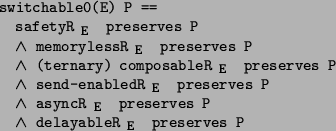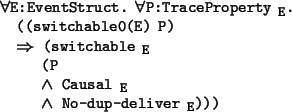


Next: About this document ...
Up: Proof of the Switch
Previous: Proof of the Switch
Having proved that out switch preserves all switchable properties, we
should show that some interesting properties are switchable.
The ``smallest'' switchable property is Causal
 No-dup-deliver
No-dup-deliver


This follows from the fact that both of the properties satisfy all six of the
metaproperties in

Any property P that satisfies these six meta-proerties can be conjoined
with Causal
 No-dup-deliver
No-dup-deliver
 to get a switchable property.
to get a switchable property.

The following recursively defined relation on lists holds when the two lists
agree on the order of the elements they have in common.

The total-order property is defined by

This says that the lists of messages delivered to any two locations
agree on the order of messages that they have in common.
This property is a ``local-deliver-property''. It only depends on some relation
on the lists tr delivered at p.

We can show that any such property is switchable,
provided the relation on the local delivery lists satisfies some closure conditions.

Using this theorem, we check the closure conditions for the relation that
defines total order, and all the conditions are met.
So we have:




Next: About this document ...
Up: Proof of the Switch
Previous: Proof of the Switch
Richard Eaton
2002-02-20




